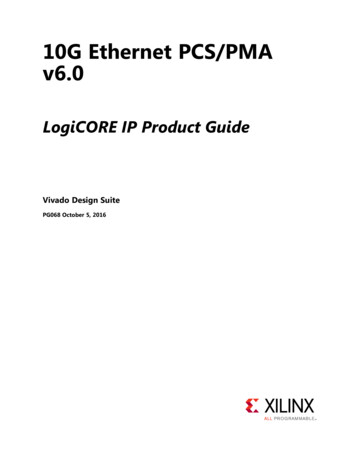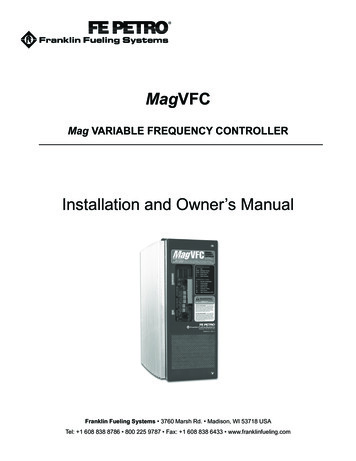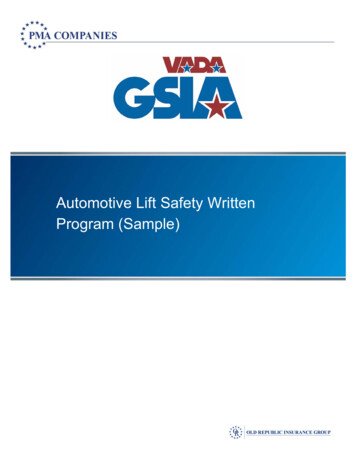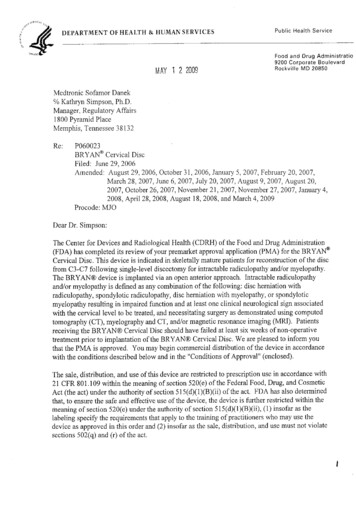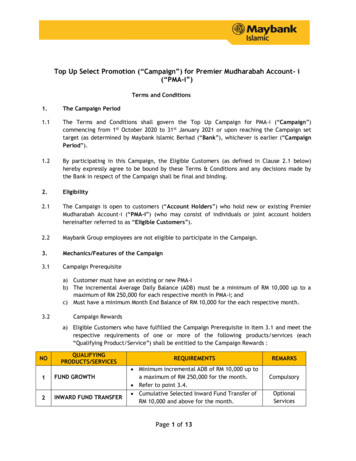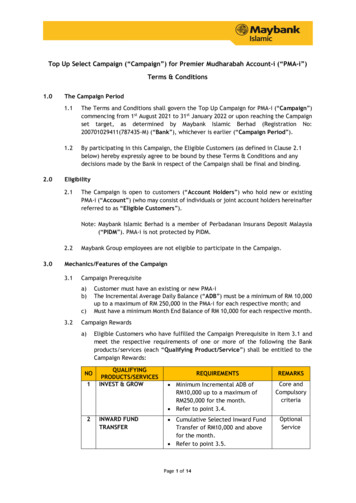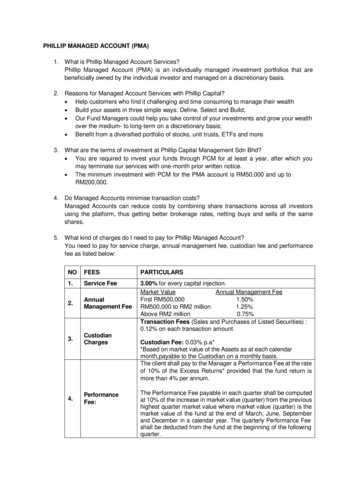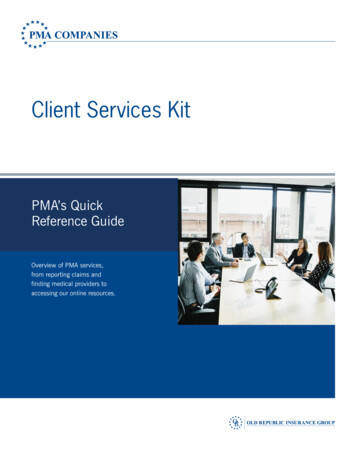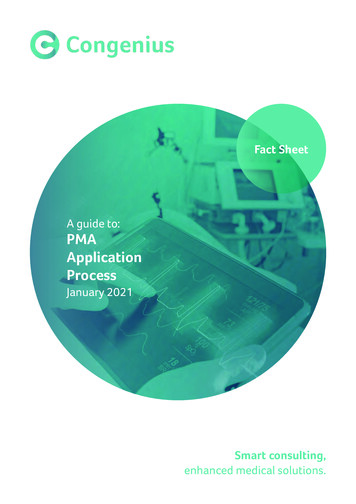
Transcription
Fact SheetA guide to:PMAApplicationProcessJanuary 2021Smart consulting,enhanced medical solutions.
A guide to the PMAApplication ProcessIntroductionPremarket approval (PMA) is the FDA process of scientific and regulatory review to evaluate the safety andeffectiveness of Class III medical devices. Class III devices are those that: Support or sustain human lifeAre of substantial importance in preventing impairment of human healthPresent a potential, unreasonable risk of illness or injuryDue to the level of risk associated with Class III devices, the FDA has determined that general and specialcontrols alone are insufficient to assure the safety and effectiveness of Class III devices.As such, these devices require a Premarket Approval (PMA) application in order to obtain marketingapproval. Some Class III pre-amendment devices may require a Class III 510(k) (see our 510(k) fact sheet formore on this).3 quick facts about the PMA application process:1. PMA is the most stringent type of device marketing application required by the FDA (becauseClass III devices fall within the most stringent regulatory category for medical devices)2. Approval of your PMA application must be received prior to marketing your device3. PMA approval is based on a determination by the FDA that your application contains sufficient validscientific evidence to assure that the device is safe and effective for its intended use(s)This fact sheet covers answers to the following questions: When is a PMA is required?What is involved in the submission?How long does a PMA application take?p1
When is a PMArequired?To help ascertain whether your devicerequires a PMA, the first step is to classifyyour device:No classification regulation in the CFR? If your PMA device involves a new concept andis not of a type that has been marketed prior tothe Medical Device Amendments, your devicewill not have a classification regulation in theCFR. In this case, the product classification databasewill only cite the device type name and productcode. If it is unclear whether your unclassified devicerequires a PMA, use the three letter productcode to search the Premarket Approval (PMA)database and the 510(k) Premarket Notificationdatabase.Device product classification can be found in theProduct Classification Database. The database searchprovides: The name of the device The device classification A link to the Code of Federal Regulations(CFR), if any are applicableDevice not found in the ProductClassification Database? If your device is a new type of high-riskdevice that cannot be found in the productclassification database, and has been foundto be not substantially equivalent (NSE) to aClass I, II, or III [Class III requiring 510(k)]device, then your device must have anapproved PMA. Some devices that are found to be notsubstantially equivalent to a cleared Class I,II, or III (not requiring PMA) device, may beeligible for the De Novo process as a Class Ior Class II device. If there are 510(k)’s cleared by the FDA andyour new device is substantially equivalent toany of these cleared devices, then you shouldsubmit a 510(k).The fees for your PMA application:The Fees for Fiscal Year 2021 (October 1, 2020 - September 30, 2021) are as follows:Standard FeeSmall business fee 365,657 91,414Note: the 510(k) fee bycomparison is 12,432Note: the 510(k) fee bycomparison is 3,108p2
What is involved in thesubmission?There are administrative elements of a PMA application, but good science and scientificwriting is key to gaining approval. The checklist below identifies some key considerations tobear in mind as you prepare your submission:Ensure all the elements listed in the administrative checklist are includedTake care to include valid clinical information and scientific analysis based on sound scientific reasoningMake sure your application is complete, accurate, consistent, and has all critical information incorporatedPerform a quality control audit of your PMA application before sending it to the FDA to ensure that it isscientifically sound and presented in a well-organised formatYour Technical sections containing data and information are particularly important, as these sections shouldallow the FDA to determine whether or not to approve your application. Divide these sections into non-clinicallaboratory studies and clinical investigationsYour Non-clinical Laboratory Studies section should include information on microbiology, toxicology,immunology, biocompatibility, stress, wear, shelf life, and other laboratory or animal tests. Non-clinical studiesfor safety evaluation must be conducted in compliance with 21 CFR Part 58 (Good Laboratory Practice forNonclinical Laboratory Studies)Your Clinical Investigations section should include study protocols, safety and effectiveness data, adversereactions and complications, device failures and replacements, patient information, patient complaints,tabulations of data from all individual subjects, results of statistical analyses, and any other information fromthe clinical investigationsAny investigation conducted under an Investigational Device Exemption (IDE) must be identified as such. Youshould also include Form FDA-3674, which is the Certification of Compliance with the Requirements ofClinicalTrials.gov Data BankSome advice for your submission:FDA may refuse to file a PMA if they determine that any of the following applies: The application is incomplete because it does not contain all the information required under section 515(c)(1)(A)-(G) of the FD&C Act The PMA does not contain each of the items required under Sec. 814.20 and justification for omission of anyitem is inadequate The applicant has a pending Premarket Notification 510(k) with respect to the same device, and FDA has notdetermined whether the device falls within the scope of Sec. 814.1(c).The PMA contains a false statement ofmaterial fact The PMA is not accompanied by a statement of either certification or disclosure as required by 21 CFR 54Financial Disclosure by Clinical InvestigatorsTop tip:The FDA suggests early collaboration to obtain further guidance prior to thesubmission of your PMA, either via a Presubmission Request or via aDetermination Meeting.p3
How long does a PMAapplication take?Step 1: Acceptance & Filing Review Administrative & limited scientific review to determinecompletenessWithin 45 days after your PMA is received by the FDA, you will be notified whether your application has been filed.Expedited review status, if appropriate, may be communicated at this time.The date of filing is the date that a PMA accepted for filing was received by the FDA.ACCEPTANCEApplication filed, proceed toSubstantive review. The 180-dayperiod for review starts on the date offiling.REFUSALFDA will refuse to file your application for substantivereview if it does not meet a minimum threshold ofacceptability. In this case, you will receive a refusal tofile notice.If the FDA refuses to file your PMA,you may submit a written requestto review the decision via informalconference with the Office ofHealth Technology Director.You may receive clarification on thedeficiencies stated in the Not FilingLetter by communicating with theReview Team (rather than byrequesting an informal conferencewith OHT Director)If you decide to request a meeting todiscuss the Not Filing Letter, youneed to choose either:1. An informal conference or2. A meeting to review thedecision not to file theapplication, including thespecific deficiencies andmeasures necessary to correctthemYou need to submit this requestwithin 10 working days of the dateof receipt of the notice refusing tofile the PMA.The FDA will not grant requests forboth.The informal conference is held by the OHT Director within 10 working days afterreceiving the requestACCEPTANCEIf the OHT Director accepts thePMA for filing, the date of filing willbe the date of the decision toaccept the PMA for filing.The OHT Director makes their decision on filing within 5 working days after theinformal conferenceREFUSALIf the OHT Director upholds the not filing decision and does not reverse thedecision, you may submit a request for reconsideration from the Office of Productand Evaluation Quality (OPEQ) Director within 30 days of receipt of the FDA’snotice of upholding the not filing decision.ACCEPTANCEIf the OPEQ Director accepts thePMA for filing, the date of filing willbe the date of the decision toaccept the PMA for filing.The OPEQ Director will provide a written decision within 60 days of receiptof the request.REFUSALIf the OPEQ Director does not reverse the not filing decision, then the PMA remainsnot filed. The OPEQ Director’s decision will constitute the final administrative actionfor the purpose of judicial review.p4
How long does a PMAapplication take? (continued)Step 2: Substantive Review In-depth scientific, regulatory, and Quality System reviewFDA will begin substantivereview of the PMA after it isaccepted for filing.You may request to meet with the FDA within100 days of the filing of the PMA to discuss thereview status of the application.During the review process,FDA will notify you via major/minor deficiency letters ofany information needed bythem to complete the reviewof your application.The procedure for "Day-100 Meetings" can befound in the guidance document here.If you need to submit a PMAamendment which containssignificant new data from apreviously unreported study,significant updated data from apreviously reported study, detailednew analyses of previouslysubmitted data, or significantrequired information previouslyomitted, the review period may beextended up to 180 days.Step 3: Panel Review Review & recommendation by the appropriate advisory committeeThe FDA may refer your PMAto an outside advisorycommittee. In general, allPMA’s for the first-of-a-kinddevice are referred. However,as soon as FDA believes that: During the review process, FDA maycommunicate with you or thecommittee to respond to questions thatmay be raised by committee members,or to provide additional information tothe panel. FDA then takes intoconsideration the transcript ofthe meeting, the panel srecommendations, and otherinformation to reach a finaldecision on your PMA1.The pertinent issues indetermining the safety andeffectiveness for the type ofmedical device areunderstood and The advisory committee will hold apublic meeting to review the PMA inaccordance with 21 CFR 14 You will then be informedwhether the FDA agrees ordisagrees with the panel srecommendation, and whatadditional information youneed to provide.2.The FDA has developed theability to address thoseissues,future PMA’s for devices ofthat type are not be takenbefore an advisory panelunless a particular applicationpresents an issue that canbest be addressed throughpanel review. They will then submit a final report tothe FDA including theirrecommendation (which can be in theform of a meeting transcript signed bythe committee chairperson) If the application is deemedapprovable, you must agree tothe "Conditions of Approval."p5
How long does a PMAapplication take? (continued)Step 4: Final deliberations, documentation, and notification of the FDA’s decisionACCEPTANCEApproval letter You will receive an approvable letter ifyour application substantially meetsthe requirements of the FD&C Act, andthe FDA believes that it can approvethe application if you agree to specificconditions / submit additionalinformation The approvable letter will describe theadditional information required toobtain approvalApproval order The FDA will issue an order to you thatyour PMA is approved They will approve your application on thebasis of draft final labelling Approval will be based on the conditionthat you submit a copy of the final printedlabelling to the FDA before marketing.REFUSALNot approvable letter You will receive a not approvable letter if the FDAbelieves that the application may not beapproved for specific reasons, or if they areunable to reach an approvable decision due to alack of significant information in your application The not approvable letter will describe thedeficiencies in your application, including eachapplicable ground for denial When practical, FDA will identify what isnecessary to make the PMA approvableIf you receive a not approvable letter you can: Amend your PMA as requested Consider the not approvable letter to be adenial of approval of the PMA and request anadministrative review by filing a petition forreconsideration Withdraw your PMAOrder denying approvalYour PMA application will be denied if: You fail to follow the requirements of the PMAregulations The FDA determines any grounds for denyingapproval as specified in the FD&C Act Your PMA contains a false statement of materialfact Your device s proposed labelling is noncompliant You do not permit an authorised FDA employeeto inspect your manufacture facilities andcontrolsFurther reading: premarketapproval-pma /pmareview-process /pmaguidance-documents subsequentdeficiencies-use-cdrh-and www.fda.gov/media/91429/download /pmaconditions-approval fdama-final-guidanceindustry-and-cdrh An essential nonclinical laboratory studydescribed in your PMA was not conducted incompliance with the good laboratory practice(GLP) regulations in 21 CFR 58, with no validreason for noncompliance provided A clinical investigation involving human subjectsdescribed in your PMA was not conducted incompliance with the applicable regulations, suchthat the rights or safety of human subjects werenot adequately protected.The order denying approval will outline thedeficiencies in your PMA, and where practical, willidentify measures required to place your PMA inapprovable form. It will also include notice of anopportunity to request a review.p6
2. Approval of your PMA application must be received prior to marketing your device 3. PMA approval is based on a determination by the FDA that your application contains sufficient valid scientific evidence to assure that the device is safe and effective for its intended use(s) A guide to the PMA Application Process 510(k) and notify you .

